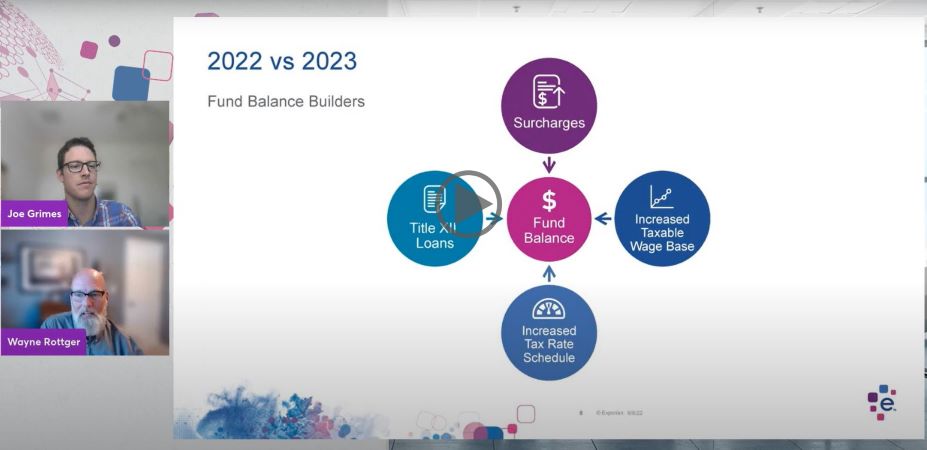Unemployment
Get up-to-date guidance on every aspect of unemployment tax compliance and establish strategies for reducing unemployment costs.

Here’s our update on 2023 compliance trends that will help employers manage changes for their organizations and prepare for new legislation.

As unemployment claims could significantly increase your UI taxes, read about the ways to reduce them through prudent policies and automated management.

Read about the effects the pandemic had on unemployment insurance benefits and imminent changes in regulations and the UI landscape.

Improve your understanding of unemployment insurance tax rates to responsibly control the costs associated with this payroll tax.

Unemployment insurance (UI) is a type of insurance that provides money to individuals on a weekly basis when they lose their job and meet certain eligibility requirements. Those who voluntarily quit or were fired for a just cause are usually not eligible for UI. However, someone separated from their job due to a lack of available work and at no fault of their own usually qualifies for unemployment benefits.Each state administers its own UI program, despite it being federal law. Unemployment benefits are primarily paid out by state governments and funded by specific payroll taxes collected for that purpose. States are free to determine the level of employer tax, the benefit level and their duration, as well as the eligibility criteria. While the U.S. Department of Labor oversees the program and ensures compliance within each state, employers need to understand different aspects of the UI program as well as the requirements for employer liability and employee eligibility. This overview will cover Washington State UI to help employers with local operations better understand the requirements. Washington State UI Tax Employers in Washington state are required to pay state unemployment taxes, administered by the Employee Security Department (ESD). Unlike the Federal Unemployment Tax Act (FUTA) demanding employers to pay unemployment taxes for employees who earned more than $1,500, employers need to pay Washington state UI tax for an employee regardless of their wages. The Engrossed Substitute Senate Bill (ESSB) 5061 was passed in February 2021 to help provide unemployment tax relief for businesses through 2025. The Washington state UI tax rate varies from company to company. The ESD usually sends out a tax rate notice in December for the following year and there are two factors that go into assigning the Washington state UI tax rate: Experience-based tax based on employers’ experience of paying unemployment benefits over the past four years; andThe social-cost tax covering the unemployment tax that cannot be recovered from a specific corporation, such as a company that went out of business. In 2022, the average Washington state UI tax rate was 1.36%. The experience tax rate has been capped at 5.4% while social tax is currently capped at 0.75% and will increase annually until it reaches 0.90% in 2025. Employers must pay Washington state UI tax on the first $62,500 of each employee’s wages, in addition to FUTA taxes. When it comes to filing and paying quarterly Washington state UI tax, employers can file online through the ESD portal, Employer Account Management Services (EAMS), SecureAccess Washington (SAW) account, or by mailing one of their original forms. Paper forms must be obtained through the ESD and cannot be copied due to a unique link used to scan information. To pay online, employers may choose to use EAMS or the ESD ePay portal. They can also pay by mail by requesting a payment voucher from the ESD. Washington state UI tax payments and reports are due every quarter by the last day of the month following the last day of each quarter. In other words: April 30;July 31;October 31; and January 31. Payments can be postmarked by the following business day if the due date falls on a weekend or holiday. Washington State UI Employee Eligibility In addition to determining employer liability for Washington state UI, ESD handles unemployment benefits and establishes eligibility on a case-by-case basis. Applicants must meet the following criteria to qualify for unemployment benefits: They must have lost employment through no fault of their own;They must have worked at least 680 hours during the base period or the first 12 months of the 15 months prior to filing a claim;They must be unemployed or partially employed and earning less than their weekly unemployment insurance benefits; andThey must be able, available and actively seeking work. To determine if workers are eligible for unemployment benefits ESD also examines the reason why they are unemployed or not working full time. As part of this process, ESD considers if applicants: Were laid off or discharged;Quit their job;Were discharged from the military;Are involved in a strike or labor dispute;Are on a leave of absence; orAre still working. Finally, ESD examines applicants’ availability for work for the weeks they claim. Workers cannot apply for unemployment benefits in Washington or file weekly claims if they did not work in this state during the past 18 months. The only exceptions are if they were in the military or worked for the federal government. Meeting UI Tax Requirements in Different States Many people mistakenly believe that unemployment benefits come from a fund paid into by employees, like Social Security or Medicare. However, employers almost entirely fund unemployment. Only three states, Alaska, New Jersey and Pennsylvania, assess unemployment taxes on employees, and it is a small portion of the overall cost. Each state has its own financing method and its own calculation to determine the tax rate employers pay, making the calculation of their organization’s unemployment tax rate a puzzle. This is especially true if an organization operates in multiple states with multiple tax finance methods. Given that higher tax rates have a long-term impact on employers, it is necessary to establish proactive measures to keep unemployment costs low. In addition to smart and prudent hiring, careful documentation, specific, actionable feedback given to employees and contesting unemployment claims, employers need to understand both federal and state requirements, including Washington state UI. To simplify this process, employers can rely on automated unemployment claims software and simplify UI claims management. As a result, they can reduce administrative burden, stay compliant with the necessary regulations and optimize state unemployment insurance tax savings.

Learn about effective ways to manage your unemployment insurance cost, improve employee retention and upgrade your human resource practices.

Read about the common reasons for the denial of unemployment benefits to better determine which claims are valid and which are not.

Stay on top of your unemployment insurance claims by avoiding the most common mistakes employers make for an unemployment hearing.

Learn how unemployment insurance affects employers across the country and what you can do to avoid UI overpayments and minimize costs.

Learn about the possibility to use reasonable assurance to effectively manage UI costs and secure future jobs for your educational institution.

Find out how to prevent UI fraud and stay better prepared for the recent rise of fraudulent activities to protect your business as well as your employees.

States are notifying employers of new unemployment tax rates for 2023. Learn how this may affect your taxes, and steps you can take to reduce your rate.

Learn about different aspects of Pennsylvania unemployment compensation to stay compliant, and control UI costs in a more effective way.

This guide to UI employer liability and employee eligibility can help you reduce your Ohio unemployment employer tax risk and maintain compliance.

Employment and income verification, unemployment management, year-end tax forms and more from a single provider improves the employee experience.

Learn more about UI employer liability and employee eligibility in Illinois to stay compliant with both state and federal regulations and reduce unnecessary costs.

This webinar provides best practices for projecting your future UI tax rate and how to adapt to a new tax landscape changed by the COVID-19 pandemic.

A FUTA credit reduction is imminent in these states for 2023, which would mean higher taxes for employers operating in these jurisdictions.